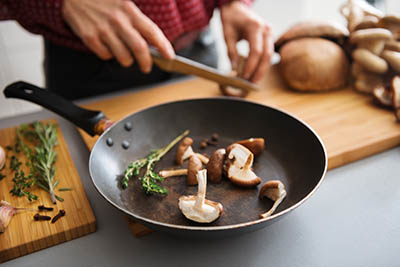
Virginia might not be known for its mushrooms, but they’re becoming increasingly popular as more growers and consumers venture into the world of fungi.
According to the U.S. Department of Agriculture’s 2017 Census of Agriculture, 41 Virginia farms grow mushrooms, accounting for about $761,000 in sales. While that’s a tiny portion of Virginia’s overall agricultural portfolio, farmers like Matthew Reiss of Gnomestead Hollow Farm and Forage in Carroll County are working to encourage more interest.
“It’s gained a lot of traction,” Reiss said. “A lot more people are growing. A lot more people are foraging, especially since the pandemic. Mushroom culture is thriving.”
Depending on the season, Reiss grows anywhere from five to 15 mushroom varieties that he sells at farmers markets and to retail stores in Floyd, Roanoke, Blacksburg and Winston-Salem, N.C. He also has a solid restaurant clientele, and noted that people enjoy mushrooms’ variety of unique, earthy flavors.
“People think ‘earthy’ tastes like dirt, but it doesn’t,” he said. “Some have this really nice, deep umami flavor like the shiitake. Oysters have a delicate, nutty flavor that intensifies when you sauté or roast them.”
Lion’s mane, with their slight seafood essence, work well for faux crab cakes. Reishi mushrooms, Reiss said, are bitter and are sometimes made into teas with ginger and honey.
Paul and Katie Schofield’s Schofield Farm in Dinwiddie County is one of the largest mushroom-growing operations in Virginia. The couple raises and harvests around 600 pounds of mushrooms each week—oysters, shiitake, lion’s mane and maitake—that they sell to farmers markets, Community Supported Agriculture farms and restaurants around Richmond and Colonial Heights.
Paul Schofield explained that when growing mushrooms, “you need the right humidity and temperature range. Blue oysters like it cooler. Shiitake like it a little bit warmer. Lion’s mane likes it kind of cool, but not cold.”
Both Reiss and Schofield mix their own substrate—typically consisting of sawdust and wheat bran—that acts as growing media for fungi. Once the substrate is inoculated with spores, the mycelium—the vegetative part of fungi—establishes and the fruiting begins.
“The lion’s mane grows slowly,” Schofield explained. “Once it starts fruiting, it’ll be seven days before they can be harvested.”
Bright yellow oysters, on the other hand, take about three days to grow, he added.
In addition to unique flavors, mushrooms are packed with health benefits. From antibacterial and antiviral properties to boosts for immune, heart and brain health, they’re also “full of vitamin D, full of protein and selenium,” Katie Schofield said.










